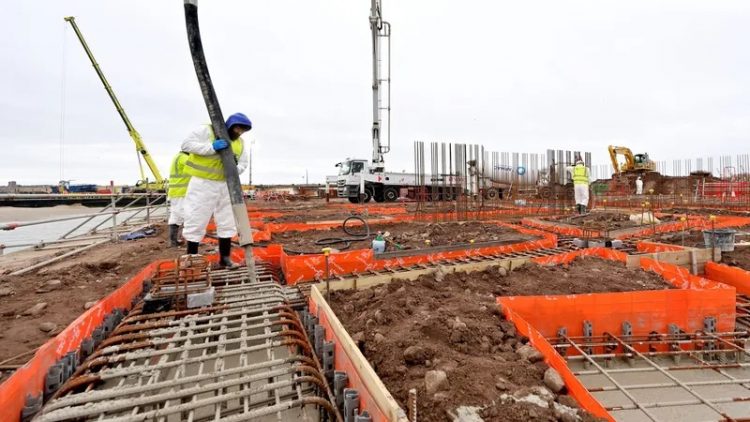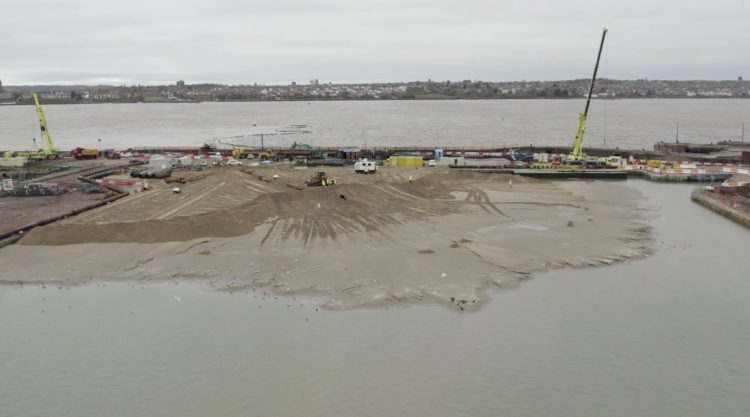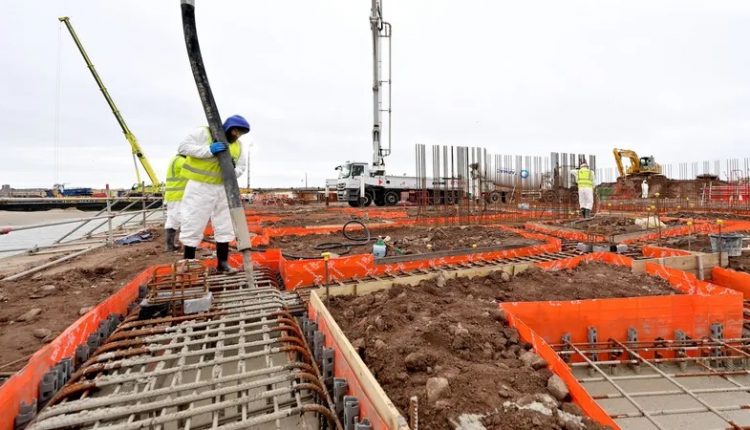Workers on Everton FC’s £500m stadium project at Bramley Moore-Dock in Liverpool Waters have reached two major milestones. Tony McDonough reports

Construction work on Everton’s £500m stadium in Liverpool’s docklands has hit two major milestones.
As part of the enabling works to prepare Bramley Moore-Dock in Liverpool Waters for the 52,888-capacity arena, the first foundations have been poured on the northern elevation in the form of a concrete pile cap.
This will create a stable base for the distribution of the building load. Three hundred of the individual, 15-20-metre deep supporting piles have now been drilled into the northern and southern wharves of the site.
Each of the 2,500 completed piles, drilled at the current rate of 21 per day, will eventually be capped and, in turn, form the sub-structure for the skeleton of the arena that will eventually rise from the ground on the waterfront site.
READ MORE: Everton steps up effort to maximise stadium revenues
David Jackson, project engineer at main contractor Laing O’Rourke, said: “It is a massive milestone to see the concrete going into the ground as we cap off some of our first piles. This also represents the first time our structural and foundation work comes above the current ground level.
“While the piling process continues across northern and southern sides of the dock, we have also been excavating and testing those piles, We’ve dropped in 30 tonnes of pre-fabricated reinforcement, put in casting items, bolt sets and drainage.
“Today we’re pouring in the concrete to cap the piles and create a stable foundation. Doing this will offer us a larger area for the distribution of the weight of the stadium on to the piles.”
Also, the infill of the Grade II-listed dock is approaching the three-quarter mark. More than 315,000 cubic meters of sand already in the dock. Eventually it will be filled with a total of 480,000 cubic metres.
The first visible signs of the transformation have become clear as the sand has broken through to the surface of the south-western edge of the dock.
Once all the water within the dock is displaced, the sand, dredged from the Irish Sea and Liverpool Bay, will be heavily compacted and topped up to form further solid foundations. At that point, piling can then commence in the infilled dock.

Andy Boynton civil engineer at Laing O’Rourke, added: “This is quite a significant moment in the infill process. Visually the sand is now above the waterline in the western section of the dock, we’ve disconnected the floating pipeline and have been discharging sand directly from the steel pipelines.
“The sand pumped in from the dredger is now being pushed around by the bulldozer on this platform of sand in the dock and will be spread east and compressed to squeeze out any moisture.
“Over the next few weeks we’ll see this rolling sand front progress over to the east side of the dock which will mean all the water will disappear. In the New Year, once the sand has been compacted, we can look at moving the piling operations into the infilled dock.”
Other developments on-site include the re-siting of welfare offices from the southern elevation to the eastern edge of the site.
Now the heritage assets which included cobbles, capstans, mooring posts and railway lines have been removed from the eastern wharf and piling has started on the southern section of the site, new offices and welfare spaces have been created for the growing number of staff expected to join the workforce at the dock in the coming year.
Work is also continuing to repair the Grade II listed hydraulic tower. Sections of the tower are painstakingly being repaired brick by brick to help ensure the structure remains sound for when the sand compacting process begins in the infilled dock.
The entire build is scheduled to take around 150 weeks in 12 separate phases. The initial enabling works are expected to take 32 weeks and are being funded by majority shareholder Farhad Moshiri. Everton aim to move out of Goodison Park and kick off the 2024/25 Premier League season in the new stadium.

